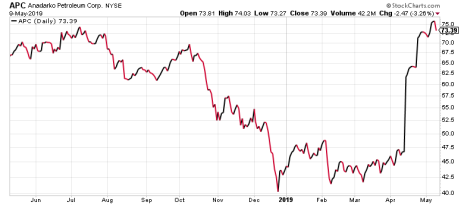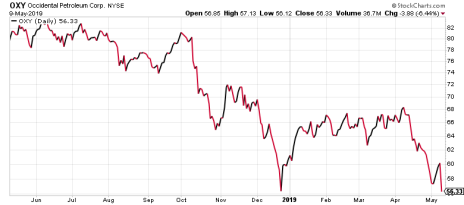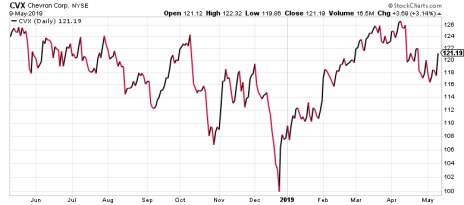Four weeks of excitement and intrigue came to a close on May 9 when Chevron Corp. (CVX) officially bowed out of the battle to purchase Anadarko Petroleum (APC), ceding the honor to Occidental Petroleum (OXY).
The drama began on April 12 when Chevron offered to buy Anadarko for $33 billion in a 25% cash/75% stock deal worth $65/share. In purchasing Anadarko, Chevron would be adding new positions in the multi-state Denver Basin and in Mozambique, while also expanding their presence in the Gulf of Mexico and the Permian Basin.
Then on April 24, Occidental made a competing offer to buy Anadarko for $38 billion in a 50% cash/50% stock deal worth $76/share. Anadarko had already agreed to be purchased by Chevron, but was suddenly forced to contemplate a more valuable transaction that also came with a higher percentage of cash.
A week later, Warren Buffett, CEO of Berkshire Hathaway (BRK/A), offered $10 billion to support Occidental Petroleum’s potential purchase. In exchange, Berkshire Hathaway would receive Occidental preferred stock with an 8% yield, and warrants that could be converted into a maximum of 80 million shares of OXY. The 8% yield is certainly a sweet deal for Berkshire Hathaway!
[text_ad]
At that point, Anadarko had two attractive suitors and a share price that had jumped 52% in 19 days.
In an effort to make their offer more attractive to Anadarko, Occidental offered two additional enticements. They upped the cash component of their offer to 78% cash/22% stock, and they vowed to sell African assets to Total SA (TOT) for $8.8 billion, in order to address concerns about leverage. (Both Anadarko and Occidental carry significantly higher debt ratios than does Chevron.)
Ultimately, Chevron decided not to outbid Occidental in the quest to purchase Anadarko. Chevron walked away with a nice parting gift; a break-up fee of $1 billion that Anadarko was required to pay Chevron as a penalty for backing out of their original agreement.
Chevron decided to use that $1 billion to increase their current share repurchase authorization from $4 billion to $5 billion.
Here’s a rundown of the fundamentals and stock chart activity for the three companies, which should help investors decide whether to buy, sell or hold.
Anadarko Stock
This stock just rose about 50% since April. It’s entirely unreasonable – dare I say “delusional” – to expect the share price to continue to climb. The classic buyout scenario is that the share price will remain stagnant from now until well after the deal closes. And of course, sometimes mergers fall through, in which case the share price plummets back to its original price. Do you want to see your APC shares fall from 73 to 46? No? Then either use a stop-loss order, or sell the stock outright.
If I owned APC, I’d thank my lucky stars for the recent capital gains, and I’d immediately sell. Then I’d reinvest the capital into an undervalued growth stock, which should dramatically increase the odds that my capital will continue to grow vs. if I had left the money languishing in shares of APC, waiting many months for the buyout to be completed.
Occidental Stock
Heading into this M&A deal, Occidental had an earnings problem. Profits were expected to fall 22.4% in 2019, and grow just 0.5% in 2020. For me, my first line of defense when searching for stocks to buy is to assess a company’s profits. That’s because over longer time frames, share price appreciation is correlated to corporate earnings growth. Why would I want to own shares of a company that’s not growing its profits? While it’s true that Anadarko will contribute an element of profit growth to Occidental, that’s not going to play out for quite a while, which leads me to my next point.
The second big problem is that when Company A buys Company B, the share price of Company A usually stagnates until about six months after the close of the merger. At that time, Wall Street is beginning to get a good feel for whether the merger is working out well. If analysts like what they’re seeing in the earnings reports and hearing from the CEO, then they might begin recommending shares of Company A to their institutional clients. But prior to that six-month post-merger moment, there are often a whole lot of “Hold” ratings coming from investment firms.
As with APC, there’s no obvious reason to own OXY right now, because there’s no particular catalyst for share price appreciation in the coming months.
Chevron Stock
Chevron just walked away from an expensive transaction, and tucked an extra $1 billion in their wallet. Nice negotiating! They’re more profitable than Occidental, with a far lower debt ratio, and a far more attractive price chart. Plus, CVX has a current dividend yield of 4%. Chevron is a great stock for dividend investors and for buy-and-hold investors who prefer to own shares of top-notch companies. (Growth stock investors and traders can find better opportunities elsewhere.)
What’s more, institutional investors all over the globe have had reason in recent weeks to reexamine CVX in light of this ongoing M&A activity. Some of them will be inclined to consider adding this high-quality energy company to their equity portfolios.
There are clear decisions to be made among this trio of energy stocks: Sell APC. Sell OXY. Consider buying CVX.
To get the list of additional stocks you can buy now, consider becoming a member of Cabot Undervalued Stocks Advisor. For more information, click here.
[author_ad]




